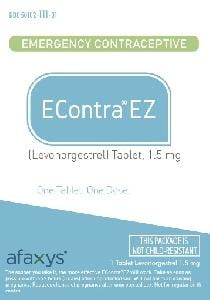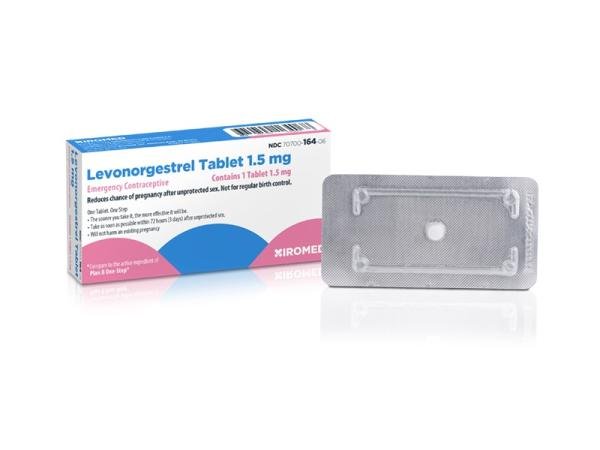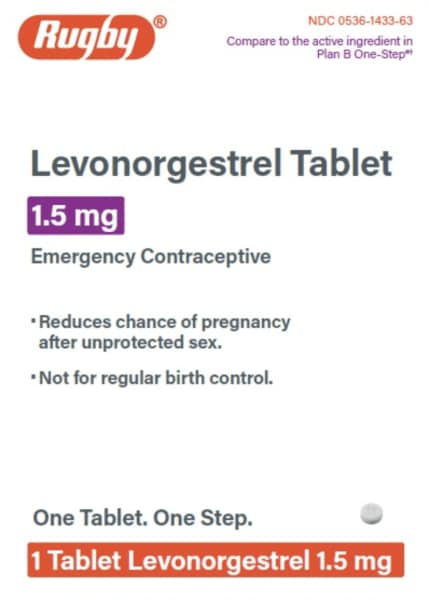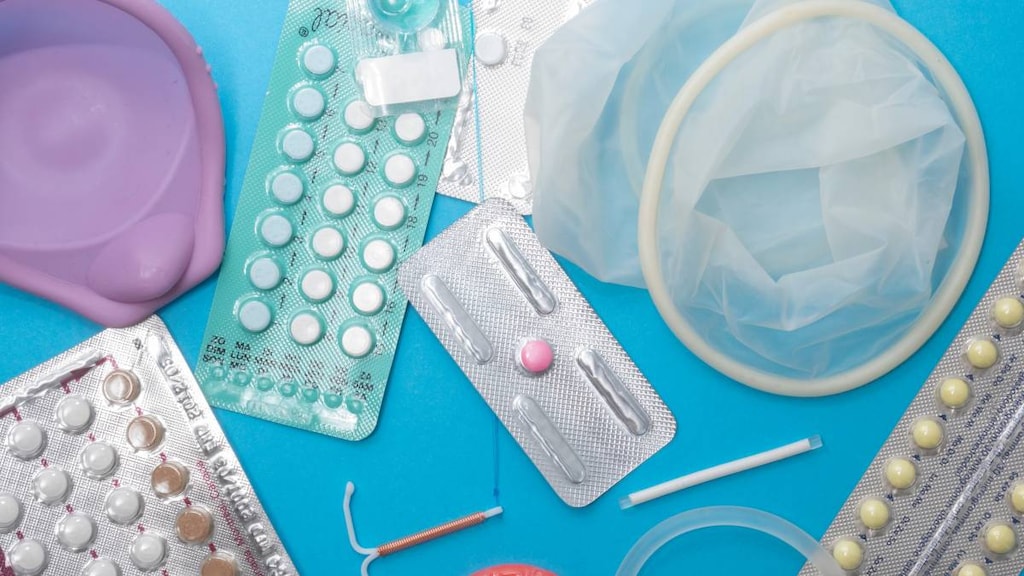Dosage Forms
Excipient information presented when available (limited, particularly for generics); consult specific product labeling.
Intrauterine Device, Intrauterine:
Kyleena: 19.5 mg
Liletta (52 MG): 19.5 mcg/day
Mirena (52 MG): 20 mcg/24 hr
Skyla: 13.5 mg
Pharmacology
Mechanism of Action
Pregnancy may be prevented through several mechanisms: Thickening of cervical mucus, which inhibits sperm passage through the uterus and sperm survival; inhibition of ovulation, from a negative feedback mechanism on the hypothalamus, leading to reduced secretion of follicle stimulating hormone (FSH) and luteinizing hormone (LH); altering the endometrium, which may affect implantation. Levonorgestrel is not effective once the implantation process has begun.
Pharmacokinetics/Pharmacodynamics
Distribution
Vd: ~1.8 L/kg
Metabolism
Hepatic via CYP3A4; forms inactive metabolites
Excretion
Urine (~45%); feces (~32%)
Duration of Action
Liletta: Up to 6 years; Kyleena, Mirena: Up to 5 years; Skyla, Jaydess [Canadian product]: Up to 3 years.
Protein Binding
Highly bound to albumin (~50%) and sex hormone-binding globulin (~47%) (Fotherby 1995)
Use: Labeled Indications
Contraception: Prevention of pregnancy (up to 3 years [Skyla], 5 years [Kyleena, Mirena], or 6 years [Liletta]).
Heavy menstrual bleeding (Mirena only): Treatment of heavy menstrual bleeding in women who also choose to use an IUD for contraception.
Use: Off Label
Endometrial hyperplasia (treatment)ayes
Data from a randomized study comparing levonorgestrel IUD and oral medroxyprogesterone demonstrated the efficacy of levonorgestrel IUD for the treatment of low- and medium-risk endometrial hyperplasia Orbo 2014. Data from a randomized study in patients with endometrial hyperplasia without atypia also support the use of levonorgestrel IUD to treat endometrial hyperplasia Dolapcioglu 2013. Clinical experience also suggests the utility of levonorgestrel IUD for non-surgical management of endometrial hyperplasia (with or without atypia) or endometrial precancers; the duration is dependent on the diagnosis (endometrial hyperplasia without atypia; benign endometrial hyperplasia/atypical hyperplasia) as well as patient specific factors Armstrong 2012, Trimble 2012. Findings from a systematic review indicate that levonorgestrel IUD may be preferred over oral progestins in the treatment of non-atypical endometrial hyperplasia Abu Hashim 2016.
According to the American College of Obstetricians and Gynecologists (ACOG) committee opinion paper on endometrial intraepithelial neoplasia (formerly called atypical endometrial hyperplasia), levonorgestrel IUD may be used in the nonsurgical management of endometrial precancers in patients who desire future fertility or who are not candidates for surgery ACOG 631 2015.
Contraindications
Hypersensitivity to levonorgestrel or any component of the formulation; pregnancy or suspected pregnancy; postcoital contraception; congenital or acquired uterine anomaly, including fibroids that distort the uterine cavity and would be incompatible with correct IUD placement; acute pelvic inflammatory disease or history of pelvic inflammatory disease (unless there has been a subsequent intrauterine pregnancy); postpartum endometritis or infected abortion within past 3 months; known or suspected uterine or cervical neoplasia; untreated acute cervicitis or vaginitis (including bacterial vaginosis, known chlamydial or gonococcal cervical infection) or other lower genital tract infections until infection is controlled; conditions which increase susceptibility to pelvic infections; unremoved IUD; uterine bleeding of unknown etiology; acute hepatic disease or hepatic tumors (benign or malignant); current or history of known or suspected breast cancer or other hormone-sensitive cancer.
Canadian labeling: Additional contraindications (not in US labeling): Bacterial endocarditis; recent trophoblastic disease while human chorionic gonadotropin (hCG) hormone levels are elevated; cervical dysplasia; known immunodeficiency or hematologic malignancy (Mirena)
Dosage and Administration
Dosing: Adult
Contraception: Females: Intrauterine device (IUD): To be inserted into uterine cavity.
Kyleena: Initially releases levonorgestrel ~17.5 mcg/day, then rate subsequently decreases; the average release rate over 5 years is levonorgestrel ~9 mcg/day. Do not leave device in place for >5 years.
Liletta: Initially releases levonorgestrel 20 mcg/day, then rate subsequently decreases; the average release rate over 6 years is levonorgestrel ~14.3 mcg/day. Do not leave in place for >6 years.
Mirena: Initially releases levonorgestrel 20 mcg/day, then rate subsequently decreases to half of that after 5 years. Do not leave device in place for >5 years.
Skyla, Jaydess [Canadian product]: Initially releases levonorgestrel ~14 mcg/day after 24 days, then rate subsequently decreases; mean release rate over 3 years is levonorgestrel ~6 mcg/day. Do not leave device in place for >3 years.
Initiation of therapy: The device may be inserted at any time in the menstrual cycle once it is determined that the woman is not pregnant; immediately postpartum; or immediately after first or second trimester spontaneous or induced abortion. Back-up contraception is not needed if insertion is within 7 days of onset of menstruation. If insertion occurs >7 days after menstrual bleeding started, an additional form of contraception must be used for 7 days unless the woman abstains from sexual intercourse. Additional contraception is not needed if IUD is placed at the time of surgical abortion. Do not administer immediately following a septic abortion (Curtis 2016a). Note: Although the aforementioned recommendations support insertion immediately postpartum or immediately after a second trimester abortion or miscarriage, the manufacturer's labeling recommends insertion of the device should not take place for at least 4 weeks or until involution of the uterus is complete in these situations (refer to the manufacturer's labeling for product specific information); appropriate timing of device insertion should be determined by the health care provider.
Continuation of contraception: When it is time to replace, device may be removed and replaced with a new device immediately, and at any time during menstrual cycle as long as the woman is not pregnant.
Additional contraceptive dosing considerations:
Switching from a different contraceptive to levonorgestrel IUD: The device may be inserted immediately if it is determined that the woman is not pregnant. Unless the woman abstains from sexual intercourse, a backup method of contraception is needed if it has been >7 days since menstrual bleeding has begun. When an additional method of contraception is needed, consider continuing the woman's previous method for 7 days after insertion (Curtis 2016a).
Switching from a copper IUD: If sexual intercourse occurred after the start of the current cycle, and it has been >5 days since bleeding began, consider administering an emergency contraceptive (Curtis 2016a).
Switching to Kyleena, Liletta, Mirena, or Skyla from an injectable progestin contraceptive: May be inserted at any time. If inserted >13 weeks after the last injection, a barrier method of contraception should be used for 7 days.
Switching to Kyleena, Liletta, Mirena, or Skyla from a contraceptive implant or another intrauterine system: May insert on the same day the implant or device is removed, any time during the menstrual cycle.
Switching to Kyleena, Liletta, Mirena, or Skyla from a hormonal contraceptive (oral, transdermal, vaginal): May be inserted anytime, including hormone free interval of the previous method. If inserted during active use of the previous method, continue previous method for 7 days after insertion or until the end of the current treatment cycle.
Switching from levonorgestrel IUD to a different contraceptive: If the patient wishes to change to a different method of birth control, may remove the device during the first 7 days of menstrual cycle and begin the new therapy. If the device is not removed during the first 7 days of menstruation (or if the patient has irregular menstrual cycles or amenorrhea) and wants to start a different method of birth control, start the new method at least 7 days prior to device removal, otherwise, a back-up barrier contraceptive should be used for 7 days after the device is removed unless the woman abstains from vaginal intercourse.
Endometrial hyperplasia, treatment (off-label use): Intrauterine device (Mirena): 20 mcg/day for hyperplasia without atypia or atypical endometrial hyperplasia/endometrial intraepithelial neoplasia. Mirena contains levonorgestrel 52 mg in a reservoir which releases ~20 mcg/day over 5 years and should be replaced after 5 years; however, the optimal duration of treatment is not known (ACOG 631 2015; Armstrong 2012; Orbo 2014; Trimble 2012).
Heavy menstrual bleeding: Females: Intrauterine device (Mirena): Refer to dosing for contraception
Dosing: Geriatric
Not indicated for use in postmenopausal women.
Dosing: Pediatric
Contraception: Females: Refer to adult dosing. Not for use prior to menarche.
Heavy menstrual bleeding: Females: Refer to adult dosing. Not for use prior to menarche.
Administration
Intrauterine device: Consider administering analgesics or cervical anesthetic prior to insertion. Insert into the uterine cavity to the recommended depth with the provided insertion device; should not be forced into the uterus. If necessary, dilate the cervical canal and consider using a paracervical block. Transvaginal ultrasound may be used to check proper placement. Remove if not positioned properly and insert a new IUD; do not reinsert removed IUD. Exclude uterine perforation if exceptional pain or bleeding occurs after insertion. Ensure device is intact after removal. Refer to manufacturer's labeling for additional administration instructions.
Storage
Jaydess [Canadian product]: Store at 15°C to 30°C (59°F to 86°F).
Liletta: Store at 20°C to 25°C (68°F to 77°F); excursions permitted between 15°C to 30°C (59°F to 86°F). Protect from light.
Kyleena, Mirena, Skyla: Store at 25°C (77°F); excursions permitted between 15°C to 30°C (59°F to 86°F).
Levonorgestrel (IUD) Images
Drug Interactions
Acitretin: May diminish the therapeutic effect of Progestins (Contraceptive). Contraceptive failure is possible. Management: Given the potential for progestin-only preparations to fail to prevent pregnancy during acitretin therapy, such products should not be relied upon. Alternative, nonhormonal forms of contraception must be employed during acitretin therapy. Consider therapy modification
Anticoagulants: Progestins may diminish the therapeutic effect of Anticoagulants. More specifically, the potential prothrombotic effects of some progestins and progestin-estrogen combinations may counteract anticoagulant effects. Management: Carefully weigh the prospective benefits of progestins against the potential increased risk of procoagulant effects and thromboembolism. Use is considered contraindicated under some circumstances. Refer to related guidelines for specific recommendations. Consider therapy modification
Antidiabetic Agents: Hyperglycemia-Associated Agents may diminish the therapeutic effect of Antidiabetic Agents. Monitor therapy
Aprepitant: May decrease the serum concentration of Progestins (Contraceptive). Management: Alternative or additional methods of contraception should be used both during treatment with aprepitant or fosaprepitant and for at least one month following the last aprepitant/fosaprepitant dose. Consider therapy modification
Artemether: May decrease the serum concentration of Progestins (Contraceptive). Management: Consider the use of an alternative (i.e., non-hormonal) means of contraception in all women of childbearing potential who are using artemether. Consider therapy modification
Atazanavir: May increase the serum concentration of Progestins (Contraceptive). However, atazanavir may lead to decreased ethinyl estradiol concentrations and decreased effectiveness of oral contraceptive products. Management: Consider an alternative or additional method of contraception, particularly with combined estrogen/progestin products. Depot medroxyprogesterone acetate may be used without a need for additional contraception. Consider therapy modification
Barbiturates: May diminish the therapeutic effect of Progestins (Contraceptive). Contraceptive failure is possible. Management: Use of alternative, nonhormonal contraceptives is recommended. Consider therapy modification
Bexarotene (Systemic): May decrease the serum concentration of Progestins (Contraceptive). Management: Women of childbearing potential receiving bexarotene should use two reliable forms of contraception (including at least one nonhormonal form). Consider therapy modification
Bile Acid Sequestrants: May decrease the serum concentration of Progestins (Contraceptive). Management: Administer oral progestin-containing contraceptives at least 1 to 4 hours prior to or 4 to 6 hours after administration of a bile acid sequestrant. Consider therapy modification
Bosentan: May decrease the serum concentration of Progestins (Contraceptive). Management: Use an alternative (i.e., non-hormonal) means of contraception for all women of childbearing potential who are using bosentan, and do not rely on hormonal contraceptives alone. Consider therapy modification
Brigatinib: May decrease the serum concentration of Progestins (Contraceptive). Management: Females of childbearing potential should use an alternative, non-hormonal contraceptive during brigatinib therapy and for at least 4 months after the final brigatinib dose. Consider therapy modification
C1 inhibitors: Progestins may enhance the thrombogenic effect of C1 inhibitors. Monitor therapy
CarBAMazepine: May diminish the therapeutic effect of Progestins (Contraceptive). Contraceptive failure is possible. Management: Use of alternative, nonhormonal contraceptives is recommended. Consider therapy modification
Carfilzomib: May enhance the thrombogenic effect of Progestins (Contraceptive). Management: Consider alternative, non-hormonal methods of contraception in patients requiring therapy with carfilzomib. Consider therapy modification
Cenobamate: May decrease the serum concentration of Hormonal Contraceptives. Management: Women should use additional or alternative non-hormonal birth control while taking cenobamate. Consider therapy modification
Cladribine: May diminish the therapeutic effect of Hormonal Contraceptives. Management: Women using systemically acting hormonal contraceptives should add a barrier method during cladribine dosing and for at least 4 weeks after the last dose in each treatment course. Consider therapy modification
CloBAZam: May decrease the serum concentration of Progestins (Contraceptive). Consider therapy modification
Cobicistat: May increase the serum concentration of Progestins (Contraceptive). Management: Consider an alternative, nonhormone-based contraceptive in patients receiving cobicistat-containing products. Drospirenone is specifically contraindicated with atazanavir and cobicistat. Consider therapy modification
Dabrafenib: May decrease the serum concentration of Progestins (Contraceptive). Management: Females of reproductive potential should use an alternative, highly effective, non-hormonal means of contraception during and at least 2 weeks (dabrafenib alone) or 4 months (dabrafenib + trametinib) after discontinuation of dabrafenib treatment. Consider therapy modification
Darunavir: May decrease the serum concentration of Progestins (Contraceptive). Management: Consider using an alternative or additional means of contraception. Injected depot medroxyprogesterone acetate may be used without a need for additional contraception. Consider therapy modification
Efavirenz: May decrease the serum concentration of Progestins (Contraceptive). Management: Use an alternative or additional method of contraception due to possibly decreased contraceptive effectiveness. Injected depot medroxyprogesterone acetate does not appear to participate in this interaction. Consider therapy modification
Elexacaftor, Tezacaftor, and Ivacaftor: Hormonal Contraceptives may enhance the adverse/toxic effect of Elexacaftor, Tezacaftor, and Ivacaftor. Specifically, the risk for rash may be increased. Monitor therapy
Encorafenib: May decrease the serum concentration of Progestins (Contraceptive). Avoid combination
Eslicarbazepine: May decrease the serum concentration of Progestins (Contraceptive). Management: Alternative, non-hormonal means of birth control should be considered for women of child-bearing potential. Consider therapy modification
Felbamate: May decrease the serum concentration of Progestins (Contraceptive). Management: Contraceptive failure is possible. Use of an alternative, nonhormonal method of contraception is recommended. Consider therapy modification
Flibanserin: Progestins (Contraceptive) may increase the serum concentration of Flibanserin. Monitor therapy
Fosamprenavir: Progestins (Contraceptive) may decrease serum concentrations of the active metabolite(s) of Fosamprenavir. Fosamprenavir may decrease the serum concentration of Progestins (Contraceptive). Management: Consider using an alternative or additional means of contraception. Injected depot medroxyprogesterone acetate may be used without a need for additional contraception. Consider therapy modification
Fosaprepitant: May decrease the serum concentration of Progestins (Contraceptive). The active metabolite aprepitant is likely responsible for this effect. Management: Alternative or additional methods of contraception should be used both during treatment with aprepitant or fosaprepitant and for at least one month following the last aprepitant/fosaprepitant dose. Consider therapy modification
Fosphenytoin: May diminish the therapeutic effect of Progestins (Contraceptive). Contraceptive failure is possible. Management: Contraceptive failure is possible. Use of an alternative, nonhormonal contraceptive is recommended. Consider therapy modification
Griseofulvin: May diminish the therapeutic effect of Progestins (Contraceptive). Contraceptive failure is possible. Avoid combination
Herbs (Progestogenic Properties) (eg, Bloodroot, Yucca): May enhance the adverse/toxic effect of Progestins. Monitor therapy
Ivosidenib: May decrease the serum concentration of Progestins (Contraceptive). Management: Consider alternative methods of contraception (ie, non-hormonal) in patients receiving ivosidenib. Consider therapy modification
Ixazomib: May decrease the serum concentration of Progestins (Contraceptive). More specifically, use of ixazomib with dexamethasone may decrease the serum concentrations of contraceptive progestins. Management: Patients of childbearing potential should use a nonhormonal barrier contraceptive during and 90 days following ixazomib treatment. Avoid combination
LamoTRIgine: May decrease the serum concentration of Progestins (Contraceptive). Monitor therapy
Lesinurad: May decrease the serum concentration of Progestins (Contraceptive). Management: Use of an additional, nonhormonal contraceptive is recommended in patients being treated with lesinurad who desire effective contraception. Consider therapy modification
Lixisenatide: May decrease the serum concentration of Progestins (Contraceptive). Management: Administer oral contraceptives 1 hour before or at least 11 hours after administration of lixisenatide. Consider therapy modification
Lopinavir: May decrease the serum concentration of Progestins (Contraceptive). Lopinavir may increase the serum concentration of Progestins (Contraceptive). Management: Consider using an alternative or additional means of contraception. Injected depot medroxyprogesterone acetate and etonogestrel implants may be used without a need for additional contraception. Consider therapy modification
Lumacaftor and Ivacaftor: May decrease the serum concentration of Hormonal Contraceptives. Management: Do not rely on hormone-based contraceptives with concurrent use of lumacaftor/ivacaftor; an alternative, non-hormonal, method of contraception should be used if this combination is required. Consider therapy modification
Metreleptin: May decrease the serum concentration of Progestins (Contraceptive). Metreleptin may increase the serum concentration of Progestins (Contraceptive). Monitor therapy
MiFEPRIStone: May diminish the therapeutic effect of Progestins (Contraceptive). MiFEPRIStone may increase the serum concentration of Progestins (Contraceptive). Management: Women of childbearing potential should use an effective, nonhormonal means of contraception during and 4 weeks following mifepristone treatment. Consider therapy modification
Mycophenolate: May decrease the serum concentration of Progestins (Contraceptive). Management: Use of an additional or alternative (nonhormonal) method of contraception should be considered. Consider therapy modification
Nelfinavir: May decrease the serum concentration of Progestins (Contraceptive). Management: Use an alternative or additional method of contraception due to possibly decreased contraceptive effectiveness. Injected depot medroxyprogesterone acetate does not appear to participate in this interaction. Consider therapy modification
OXcarbazepine: May decrease the serum concentration of Progestins (Contraceptive). Management: Contraceptive failure is possible. Use of an additional or alternative, nonhormonal method of contraception is recommended. Consider therapy modification
Perampanel: May decrease the serum concentration of Progestins (Contraceptive). Management: Patients should use an alternative, nonhormonal-based form of contraception both during the concurrent use of perampanel and for 1 month after discontinuing perampanel. Consider therapy modification
Phenytoin: May diminish the therapeutic effect of Progestins (Contraceptive). Contraceptive failure is possible. Management: Contraceptive failure is possible. Use of an alternative, nonhormonal contraceptive is recommended. Consider therapy modification
Pitolisant: May decrease the serum concentration of Hormonal Contraceptives. Management: Patients using hormonal contraception should be advised to use an alternative non-hormonal contraceptive method during treatment with pitolisant and for at least 21 days after discontinuation of pitolisant treatment. Consider therapy modification
Pomalidomide: Progestins may enhance the thrombogenic effect of Pomalidomide. Management: Canadian pomalidomide labeling recommends caution with use of hormone replacement therapy and states that hormonal contraceptives are not recommended. US pomalidomide labeling does not contain these specific recommendations. Consider therapy modification
Primidone: May diminish the therapeutic effect of Progestins (Contraceptive). Contraceptive failure is possible. Management: Use of alternative, nonhormonal contraceptives is recommended. Consider therapy modification
Retinoic Acid Derivatives: May diminish the therapeutic effect of Progestins (Contraceptive). Retinoic Acid Derivatives may decrease the serum concentration of Progestins (Contraceptive). Management: Two forms of effective contraception should be used in patients receiving retinoic acid derivatives. Microdosed progesterone-only preparations (ie, minipills that do not contain estrogen) are considered an inadequate method of contraception. Exceptions: Adapalene; Alitretinoin (Topical); Bexarotene (Topical); Tretinoin (Topical). Consider therapy modification
Rifamycin Derivatives: May decrease the serum concentration of Progestins (Contraceptive). Contraceptive failure is possible. Management: Contraceptive failure is possible. Use of an alternative, nonhormonal contraceptive is recommended. Consider therapy modification
Saquinavir: May decrease the serum concentration of Progestins (Contraceptive). Management: Use an alternative or additional method of contraception due to possibly decreased contraceptive effectiveness. Injected depot medroxyprogesterone acetate does not appear to participate in this interaction. Consider therapy modification
Selegiline: Progestins (Contraceptive) may increase the serum concentration of Selegiline. Monitor therapy
St John's Wort: May diminish the therapeutic effect of Progestins (Contraceptive). Contraceptive failure is possible. Management: Consider using a product other than St John's wort. Contraceptive failure is possible. Use of an alternative, nonhormonal contraceptive is recommended. Consider therapy modification
Sugammadex: May decrease the serum concentration of Progestins (Contraceptive). Management: Patients receiving any hormonal contraceptive (oral or non-oral) should use an additional, nonhormonal contraceptive method during and for 7 days following sugammadex treatment. Consider therapy modification
Tazemetostat: May decrease the serum concentration of Hormonal Contraceptives. Management: Women of reproductive potential should use a non-hormonal contraceptive method during treatment with tazemetostat and for 6 months after. Men with female partners should use contraception during treatment and for 3 months after. Consider therapy modification
Tetrahydrocannabinol and Cannabidiol: May decrease the serum concentration of Hormonal Contraceptives. Management: Women using hormonal contraceptives should consider adding a barrier contraceptive due to the potential for tetrahydrocannabinol and cannabidiol to decrease concentrations and effectiveness of hormonal contraceptives. Consider therapy modification
Thalidomide: Progestins (Contraceptive) may enhance the thrombogenic effect of Thalidomide. Monitor therapy
Tipranavir: May increase the serum concentration of Progestins (Contraceptive). Management: Use an alternative or additional method of contraception due to possibly decreased contraceptive effectiveness. Injected depot medroxyprogesterone acetate does not appear to participate in this interaction. Consider therapy modification
Topiramate: May decrease the serum concentration of Progestins (Contraceptive). Management: Caution patients that this combination may be associated with reduced contraceptive effectiveness. Consider adding an additional (non-hormonal) contraceptive method. Consider therapy modification
Tranexamic Acid: Progestins (Contraceptive) may enhance the thrombogenic effect of Tranexamic Acid. Avoid combination
Triazolam: Hormonal Contraceptives may increase the serum concentration of Triazolam. Monitor therapy
Ulipristal: Progestins may diminish the therapeutic effect of Ulipristal. Ulipristal may diminish the therapeutic effect of Progestins. Management: Ulipristal for uterine fibroids (Canadian indication): avoid progestins within 12 days of stopping ulipristal; as emergency contraceptive (U.S. indication): avoid progestins within 5 days of stopping ulipristal. Avoid combination
Vitamin K Antagonists (eg, warfarin): Progestins (Contraceptive) may diminish the anticoagulant effect of Vitamin K Antagonists. In contrast, enhanced anticoagulant effects have also been noted with some products. Management: When possible, concomitant hormonal contraceptives and coumarin derivatives should be avoided in order to eliminate the risk of thromboembolic disorders. Consider using an alternative, nonhormonal contraceptive. Consider therapy modification
Voriconazole: May increase the serum concentration of Progestins (Contraceptive). Progestins (Contraceptive) may increase the serum concentration of Voriconazole. Monitor therapy
Adverse Reactions
>10%:
Central nervous system: Headache (≤16%), migraine (≤16%)
Dermatologic: Acne vulgaris (6% to 15%), seborrhea (1% to 15%)
Endocrine & metabolic: Heavy menstrual bleeding (5% to 59%; generally bleeding lessens after the first 90 days), amenorrhea (≤42%, increases with duration of treatment), intermenstrual bleeding (23%), ovarian cyst (5% to 22%; includes symptomatic and asymptomatic cysts)
Gastrointestinal: Abdominal pain (≤23%)
Genitourinary: Abnormal uterine bleeding (52%), irregular menses (25% to 43%; menses becomes more regular after the first 90 days), vulvovaginitis (11% to 24%), pelvic pain (≤23%), vaginal infection (9% to 19%), vulvovaginal infection (8% to 19%), vaginal discharge (4% to 15%)
1% to 10%:
Central nervous system: Anxiety (9%), depression (4% to 8%), mood changes (6%)
Dermatologic: Pruritus (<5%), skin rash (<5%), urticaria (<5%), alopecia (1%)
Endocrine & metabolic: Infrequent uterine bleeding (8% to 10%; periods may become more infrequent after the first 90 days), weight gain (6%), decreased libido (<5%), hirsutism (<5%)
Gastrointestinal: Abdominal distress (≤10%), nausea (≤10%), vomiting (≤10%)
Genitourinary: Breast tenderness (≤10%), dysmenorrhea (≤10%), uterine spasm (≤10%), mastalgia (3% to 10%), dyspareunia (9%), endometritis (≤2%), genitourinary infection (1% to 2%)
Neuromuscular & skeletal: Back pain (6% to 8%)
Frequency not defined: Central nervous system: Bipolar mood disorder (exacerbation), exacerbation of depression, suicidal tendencies
<1%, postmarketing, and/or case reports: Acute myocardial infarction, angioedema, arterial thromboembolism, cerebrovascular accident, deep vein thrombosis, hypersensitivity reaction, increased blood pressure, jaundice, malignant neoplasm of breast, pelvic inflammatory disease, sepsis (including Group A streptococcal sepsis), uterine hemorrhage, uterine perforation, venous thromboembolism
Warnings/Precautions
Concerns related to adverse effects:
- Bleeding irregularities: Menstrual bleeding patterns may be altered, especially during the first 3 to 6 months with use of the intrauterine device (IUD) and result in spotting, irregular bleeding, heavy bleeding, oligomenorrhea, and amenorrhea; the possibility of pregnancy should be considered if menstruation does not occur within 6 weeks of the previous menstrual period. If significant bleeding irregularities continue with prolonged use, conduct diagnostic tests to assess possible endometrial pathology (polyps or cancer). An increase in menstrual bleeding may indicate a partial or complete expulsion of the IUD (see dosage form specific issues). Unexplained vaginal bleeding should be evaluated prior to insertion (Curtis 2016b); use is contraindicated with unexplained uterine bleeding.
- Bradycardia/syncope: Bradycardia or syncope may occur during insertion or removal of the IUD; use with caution in patients predisposed to these conditions.
- Breast cancer: Breast cancer is a hormonal sensitive tumor. Use is contraindicated in women with (or history of) breast cancer. Reports of breast cancer have been reported with levonorgestrel-releasing IUDs.
- Ectopic pregnancy: Use caution in patients with previous ectopic pregnancy. Women with history of ectopic pregnancy were excluded from clinical trials; women with previous ectopic pregnancy, tubal surgery, or pelvic infection may be at increased risk for ectopic pregnancy. The possibility of ectopic pregnancy should be considered in patients with lower abdominal pain, especially in association with missed periods or new-onset vaginal bleeding in women with prior amenorrhea. Ectopic pregnancy may result in loss of fertility.
- Ocular effects: IUD may need to be removed (temporarily or permanently) if ophthalmic problems or discomfort occur, including issues related to contact lenses.
- Ovarian cysts: May occur during IUD use; most are asymptomatic and disappear spontaneously within 2 to 3 months. Evaluate if persistent.
- Pelvic inflammatory disease: An increased incidence of group A streptococcal sepsis, pelvic inflammatory disease (PID) or endometritis (may be asymptomatic), and actinomycosis has been reported with use. Using aseptic technique during insertion is essential to minimizing the risk of serious infections. PID occurs more frequently within the first year and most often within the first month after insertion; risk is increased with multiple sexual partners. Women with a history of PID or endometritis are at increased risk. If PID is diagnosed, treat according to current guidelines and reassess in 48 to 72 hours. If there is no clinical improvement, continue antibiotics and consider removal of device (Curtis 2016a). Women with symptomatic actinomycosis should have the device removed and be treated with the appropriate antibiotics. Remove IUD in cases of recurrent endometritis or PID, or if an acute pelvic infection is severe or does not respond to treatment.
- Seizure: Insertion or removal may be associated with seizure, especially in patients predisposed to seizures.
Disease-related concerns:
- Cervical or endometrial cancer: Women diagnosed with cervical or endometrial cancer prior to IUD insertion should not use an IUD for pregnancy prevention (may have in increased risk of bleeding or infection when the device is inserted). Women diagnosed after insertion of an IUD may continue; however, the IUD will most likely need to be removed during treatment (Curtis 2016b). Use is contraindicated in women with progestin sensitive cancer.
- Depression: Use with caution in patients with depression; may be more susceptible to recurrence of depressive episodes; consider removal of IUD for serious recurrence. Depression is not a contraindication to use of the IUD (Curtis 2016b).
- Gestational trophoblastic disease: Women with gestational trophoblastic disease are at increased risk of adverse events if pregnancy occurs; use of the levonorgestrel IUD may be appropriate for prevention of pregnancy in some situations with close medical supervision. However, women with persistently elevated beta-hCG concentrations or malignant disease with evidence or suspicion of intrauterine disease should not initiate therapy with a levonorgestrel IUD due to risks of infection, hemorrhage, or perforation. Consider benefits of effective contraception versus risks of continuation/removal in women who have a levonorgestrel IUD already in place (Curtis 2016b).
- Sepsis: The levonorgestrel IUD should not be inserted in women with postpartum sepsis or immediately following a septic abortion (Curtis 2016b).
- Sexually transmitted disease: Use of the levonorgestrel IUD should not be initiated in women with purulent cervicitis, chlamydial, or gonococcal infection. The IUD does not need to be removed if diagnosis occurs with the IUD in place, as long as there is treatment with appropriate antibiotics, and consideration is given to personal risk factors and patient preference (Curtis 2016b).
- Tuberculosis: The levonorgestrel IUD may be inserted in women with nonpelvic tuberculosis; do not initiate treatment in cases of pelvic infection and consider removal when pelvic infection occurs with the IUD in place (Curtis 2016b).
Concurrent drug therapy issues:
- Drug-drug interactions: Potentially significant interactions may exist, requiring dose or frequency adjustment, additional monitoring, and/or selection of alternative therapy. Consult drug interactions database for more detailed information.
Special populations:
- Obesity: Obesity is not a contraindication to levonorgestrel IUD use; clinical trials did not exclude women based on BMI (Curtis 2016a).
- Pediatric: Not for use prior to menarche.
- Postmenopausal women: Not indicated for use in postmenopausal women.
- Smokers: The risk of cardiovascular side effects increases in women using estrogen containing combined hormonal contraceptives and who smoke cigarettes, especially those who are >35 years of age. This risk relative to progestin-only contraceptives has not been established. Women who take contraceptives should be advised not to smoke. Smoking is not a contraindication to use of the IUD (Curtis 2016b).
Dosage form specific issues:
- Consent form: Some products provide a consent form; a copy of the form and lot number should be kept with the woman's medical record.
- Expulsion: Partial or complete expulsion may occur; may be associated with symptoms of bleeding or pain or may be asymptomatic and go unnoticed. An increase in menstrual bleeding may indicate a partial or complete expulsion of the IUD. If the IUD is not found in the uterus, consider further testing to confirm expulsion (eg, sonography, X-ray). The risk of expulsion may be increased when the uterus is not completely involuted. If expulsion occurs, remove device; may replace device any time the health care professional assesses that the woman is not pregnant.
- MRI: Only under specific conditions may an IUD be scanned safely by MRI (refer to manufacturer's labeling for requirements). Image quality may also be impaired if area of interest is relatively close to the device.
- Perforation: Total or partial perforation may occur, most often during insertion but can occur at any time during use. Perforation may include penetration/embedment in the uterus or cervix; risk of perforation is increased in lactating women and when the uterus is fixed retroverted or not completely involuted during the postpartum period. Perforation may reduce contraceptive efficacy and result in pregnancy. If perforation occurs, locate and remove IUD; delayed detection or removal in cases of perforation may result in migration of IUD outside of uterine cavity, adhesions, peritonitis, intestinal perforations, intestinal obstruction, abscesses, and erosion of adjacent viscera.
Other warnings/precautions:
- Appropriate use: IUD: Insertion should be done by a trained health care provider. Insertion and removal may be associated with pain and/or bleeding; consider analgesics prior to insertion. Removal of the device may be necessary for the following reasons: pelvic infection or disease, endometritis, symptomatic genital actinomycosis, uterine or cervical cancer, uterine or cervical perforation, partial expulsion, and pregnancy. Use with caution if any of the following conditions exist and consider removal if any of them arise during use: Coagulopathy or are receiving anticoagulants; marked increase of blood pressure; severe arterial disease, such as stroke or MI; exceptionally severe headache; and migraine, focal migraine with asymmetrical visual loss, or other symptoms indicating transient cerebral ischemia. In addition, consider removal if jaundice occurs during use. Not effective for emergency contraception.
- HIV infection protection: Intrauterine devices do not protect against HIV infection or other sexually transmitted diseases (Curtis 2016b).
- Laboratory changes: The use of estrogens and/or progestins may change the results of some laboratory tests (eg, coagulation factors, lipids, glucose tolerance, binding proteins). The dose, route, and the specific estrogen/progestin influences these changes. In addition, personal risk factors (eg, cardiovascular disease, smoking, diabetes, age) also contribute to adverse events; use of specific products may be contraindicated in women with certain risk factors.
Monitoring Parameters
Prior to insertion: Assessment of pregnancy status; bimanual examination and cervical inspection; weight (optional; BMI at baseline may be helpful to monitor changes during therapy); STD screen (unless already screened according to CDC STD Treatment guidelines) (Curtis 2016a). Complete medical and social history which may determine conditions influencing an IUD use for contraception.
Following insertion: Transvaginal ultrasound may be used to check placement. Changes in health status (including medications) should be assessed at routine follow-up visits (Curtis 2016a). Re-examine following insertion (4 to 6 weeks Kyleena, Liletta, Mirena, Skyla; 4 to 12 weeks Jaydess [Canadian product]) and then yearly or more frequently if necessary. Threads should be visible; if length of thread has changed device may have become displaced, broken, perforated the uterus, or expelled. Monitor for significant changes in menstrual bleeding during prolonged use, Pap smear, blood pressure, serum glucose in patients with diabetes. Patients presenting with lower abdominal pain should be evaluated for ovarian cysts and ectopic pregnancy. Signs of infection. Monitor for signs/symptoms of thromboembolism in women who require surgery with prolonged immobilization.
Endometrial hyperplasia, treatment (off-label use): Endometrial sampling every 3 to 6 months, although most appropriate frequency has not been determined (ACOG 631 2015; Trimble 2012).
Pregnancy
Pregnancy Considerations
Use during pregnancy or a suspected pregnancy is contraindicated.
Evaluate pregnancy status prior to insertion. Women who become pregnant with an IUD in place risk septic abortion; septicemia, septic shock, and death may occur. Removal of the device is recommended; however, removal or manipulation of IUD or probing of the uterus may result in pregnancy loss. In addition, if pregnancy occurs with an IUD in place, the likelihood of ectopic pregnancy is increased; miscarriage, sepsis, premature labor, and premature delivery may occur if pregnancy is continued.
The device may be inserted immediately following a first trimester-induced or spontaneous abortion. Following pregnancy or a second trimester-induced or spontaneous abortion, the manufacturer recommends that insertion of the device should not take place for at least 6 weeks or until involution of the uterus is complete. However, evidence-based guidelines recommend that insertion postpartum (immediate insertion within 10 minutes of placental delivery or interval insertion during the 6-week postpartum period) or following an abortion are safe despite a higher risk of expulsion immediately postpartum and following a second trimester abortion and may be offered regardless of breastfeeding status to help prevent rapid repeat and unintended pregnancies (ACOG 186 2017; Curtis 2016b).
Following removal of the device, ~71% to 88% of women who wished to conceive became pregnant within 12 months.
Patient Education
What is this drug used for?
- It is used to prevent pregnancy and heavy bleeding during monthly periods (menstruation).
Frequently reported side effects of this drug
- Acne
- Vomiting
- Nausea
Other side effects of this drug: Talk with your doctor right away if you have any of these signs of:
- Severe cerebrovascular disease like change in strength on one side is greater than the other, difficulty speaking or thinking, change in balance, or vision changes
- Pain where device placed
- Chest pain
- Dizziness
- Passing out
- Vision changes
- Abdominal pain
- Pelvic pain
- Abnormal vaginal bleeding
- Vaginal pain, itching, and discharge
- Chills
- Lump in breast
- Breast soreness
- Device complication
- Painful intercourse
- Severe headache
- Seizures
- Slow heartbeat
- Yellow skin
- Mood changes
- Depression
- Genital sores
- Signs of a significant reaction like wheezing; chest tightness; fever; itching; bad cough; blue skin color; seizures; or swelling of face, lips, tongue, or throat.
Note: This is not a comprehensive list of all side effects. Talk to your doctor if you have questions.
Consumer Information Use and Disclaimer: This information should not be used to decide whether or not to take this medicine or any other medicine. Only the healthcare provider has the knowledge and training to decide which medicines are right for a specific patient. This information does not endorse any medicine as safe, effective, or approved for treating any patient or health condition. This is only a brief summary of general information about this medicine. It does NOT include all information about the possible uses, directions, warnings, precautions, interactions, adverse effects, or risks that may apply to this medicine. This information is not specific medical advice and does not replace information you receive from the healthcare provider. You must talk with the healthcare provider for complete information about the risks and benefits of using this medicine.






